Importance of Human Resource Management
VerifiedAdded on 2020/09/17
|13
|3888
|38
AI Summary
This assignment explores the importance of human resource management (HRM) in a business context. It highlights the key functions of HRM, including recruitment, selection, performance evaluation, and training. The assignment also emphasizes the role of HRM in managing employee turnover, increasing productivity, and enhancing profitability. Furthermore, it discusses the significance of HR practices in promoting strong employee relations. Overall, this assignment provides a comprehensive understanding of HRM's importance in achieving business success.
Contribute Materials
Your contribution can guide someone’s learning journey. Share your
documents today.
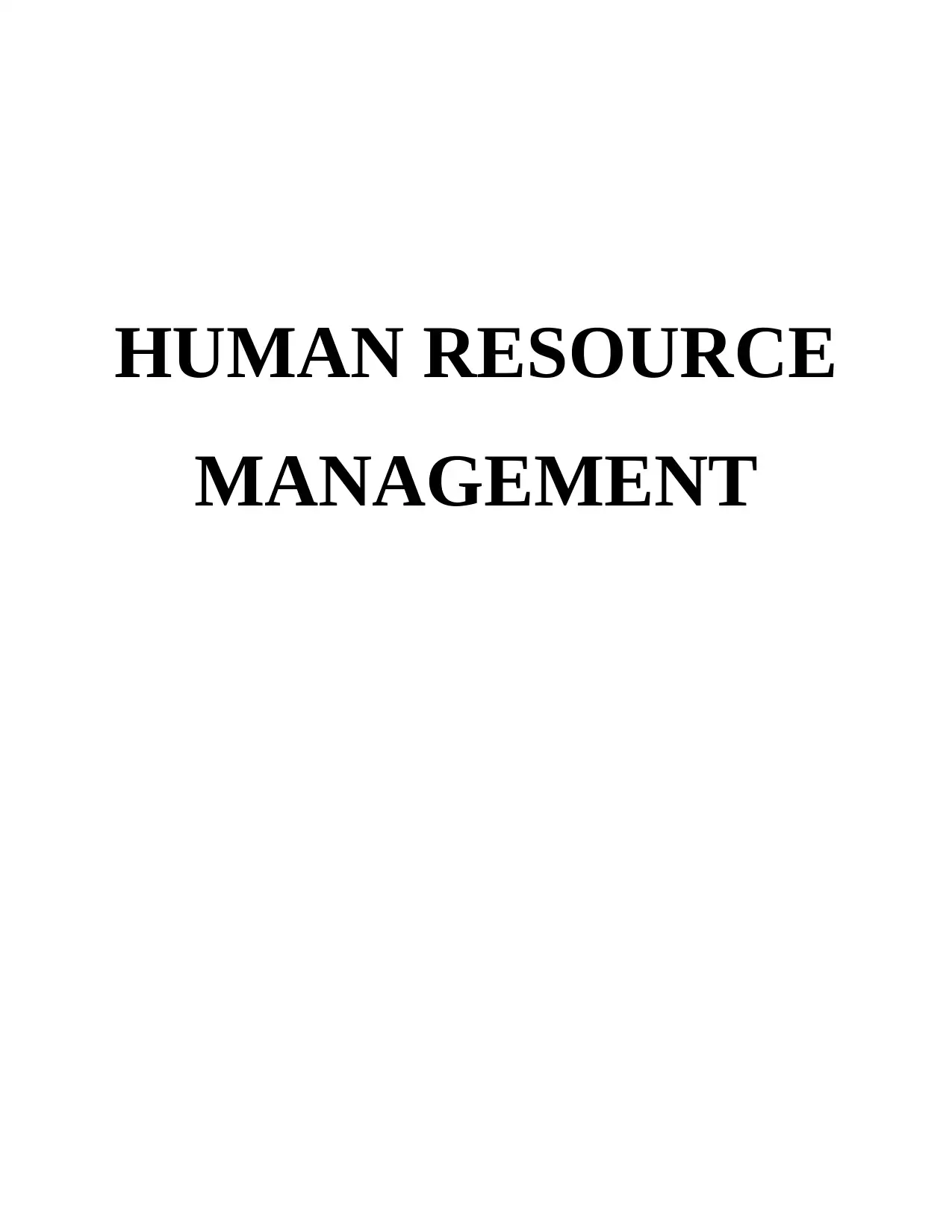
HUMAN RESOURCE
MANAGEMENT
MANAGEMENT
Secure Best Marks with AI Grader
Need help grading? Try our AI Grader for instant feedback on your assignments.
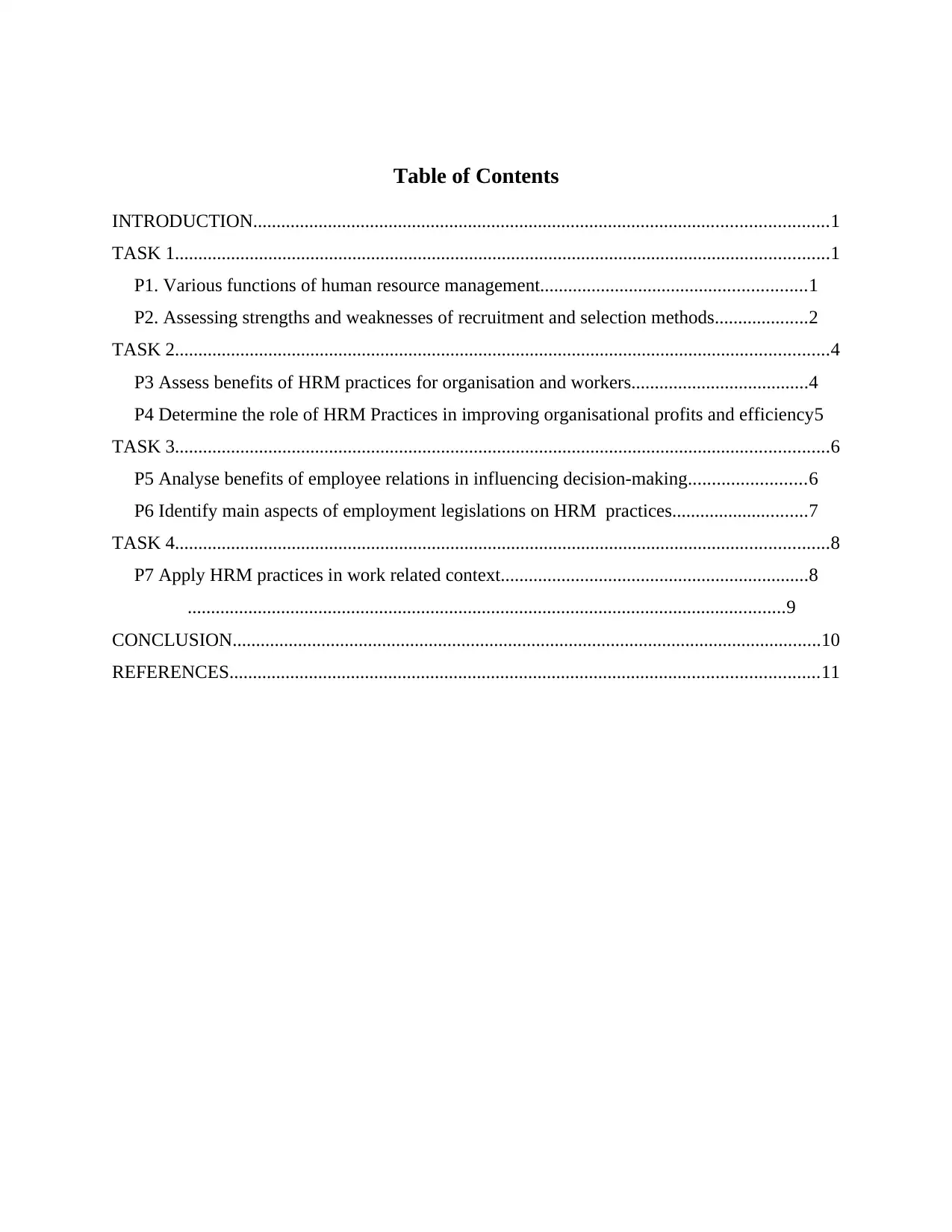
Table of Contents
INTRODUCTION...........................................................................................................................1
TASK 1............................................................................................................................................1
P1. Various functions of human resource management.........................................................1
P2. Assessing strengths and weaknesses of recruitment and selection methods....................2
TASK 2............................................................................................................................................4
P3 Assess benefits of HRM practices for organisation and workers......................................4
P4 Determine the role of HRM Practices in improving organisational profits and efficiency5
TASK 3............................................................................................................................................6
P5 Analyse benefits of employee relations in influencing decision-making.........................6
P6 Identify main aspects of employment legislations on HRM practices.............................7
TASK 4............................................................................................................................................8
P7 Apply HRM practices in work related context..................................................................8
................................................................................................................................9
CONCLUSION..............................................................................................................................10
REFERENCES..............................................................................................................................11
INTRODUCTION...........................................................................................................................1
TASK 1............................................................................................................................................1
P1. Various functions of human resource management.........................................................1
P2. Assessing strengths and weaknesses of recruitment and selection methods....................2
TASK 2............................................................................................................................................4
P3 Assess benefits of HRM practices for organisation and workers......................................4
P4 Determine the role of HRM Practices in improving organisational profits and efficiency5
TASK 3............................................................................................................................................6
P5 Analyse benefits of employee relations in influencing decision-making.........................6
P6 Identify main aspects of employment legislations on HRM practices.............................7
TASK 4............................................................................................................................................8
P7 Apply HRM practices in work related context..................................................................8
................................................................................................................................9
CONCLUSION..............................................................................................................................10
REFERENCES..............................................................................................................................11
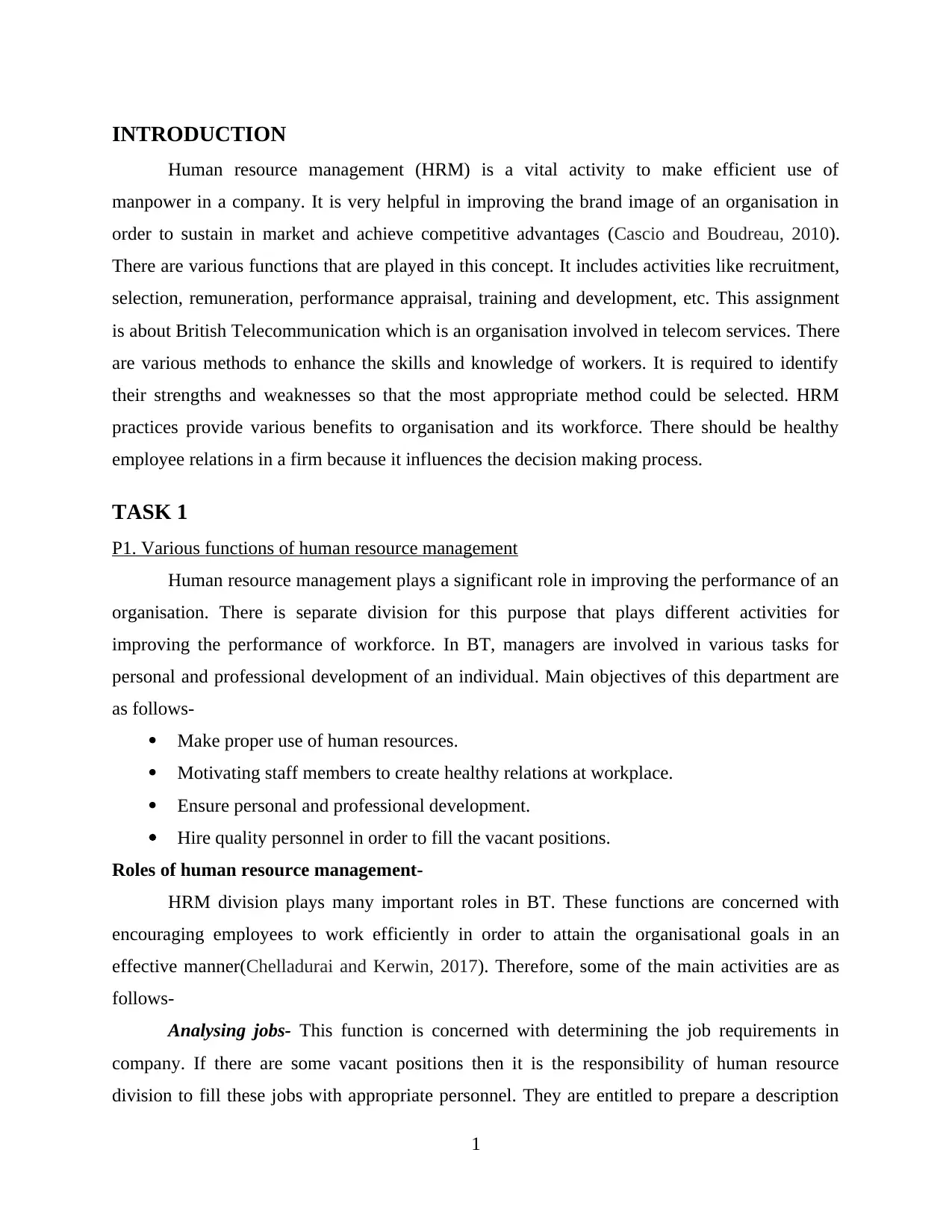
INTRODUCTION
Human resource management (HRM) is a vital activity to make efficient use of
manpower in a company. It is very helpful in improving the brand image of an organisation in
order to sustain in market and achieve competitive advantages (Cascio and Boudreau, 2010).
There are various functions that are played in this concept. It includes activities like recruitment,
selection, remuneration, performance appraisal, training and development, etc. This assignment
is about British Telecommunication which is an organisation involved in telecom services. There
are various methods to enhance the skills and knowledge of workers. It is required to identify
their strengths and weaknesses so that the most appropriate method could be selected. HRM
practices provide various benefits to organisation and its workforce. There should be healthy
employee relations in a firm because it influences the decision making process.
TASK 1
P1. Various functions of human resource management
Human resource management plays a significant role in improving the performance of an
organisation. There is separate division for this purpose that plays different activities for
improving the performance of workforce. In BT, managers are involved in various tasks for
personal and professional development of an individual. Main objectives of this department are
as follows-
Make proper use of human resources.
Motivating staff members to create healthy relations at workplace.
Ensure personal and professional development.
Hire quality personnel in order to fill the vacant positions.
Roles of human resource management-
HRM division plays many important roles in BT. These functions are concerned with
encouraging employees to work efficiently in order to attain the organisational goals in an
effective manner(Chelladurai and Kerwin, 2017). Therefore, some of the main activities are as
follows-
Analysing jobs- This function is concerned with determining the job requirements in
company. If there are some vacant positions then it is the responsibility of human resource
division to fill these jobs with appropriate personnel. They are entitled to prepare a description
1
Human resource management (HRM) is a vital activity to make efficient use of
manpower in a company. It is very helpful in improving the brand image of an organisation in
order to sustain in market and achieve competitive advantages (Cascio and Boudreau, 2010).
There are various functions that are played in this concept. It includes activities like recruitment,
selection, remuneration, performance appraisal, training and development, etc. This assignment
is about British Telecommunication which is an organisation involved in telecom services. There
are various methods to enhance the skills and knowledge of workers. It is required to identify
their strengths and weaknesses so that the most appropriate method could be selected. HRM
practices provide various benefits to organisation and its workforce. There should be healthy
employee relations in a firm because it influences the decision making process.
TASK 1
P1. Various functions of human resource management
Human resource management plays a significant role in improving the performance of an
organisation. There is separate division for this purpose that plays different activities for
improving the performance of workforce. In BT, managers are involved in various tasks for
personal and professional development of an individual. Main objectives of this department are
as follows-
Make proper use of human resources.
Motivating staff members to create healthy relations at workplace.
Ensure personal and professional development.
Hire quality personnel in order to fill the vacant positions.
Roles of human resource management-
HRM division plays many important roles in BT. These functions are concerned with
encouraging employees to work efficiently in order to attain the organisational goals in an
effective manner(Chelladurai and Kerwin, 2017). Therefore, some of the main activities are as
follows-
Analysing jobs- This function is concerned with determining the job requirements in
company. If there are some vacant positions then it is the responsibility of human resource
division to fill these jobs with appropriate personnel. They are entitled to prepare a description
1
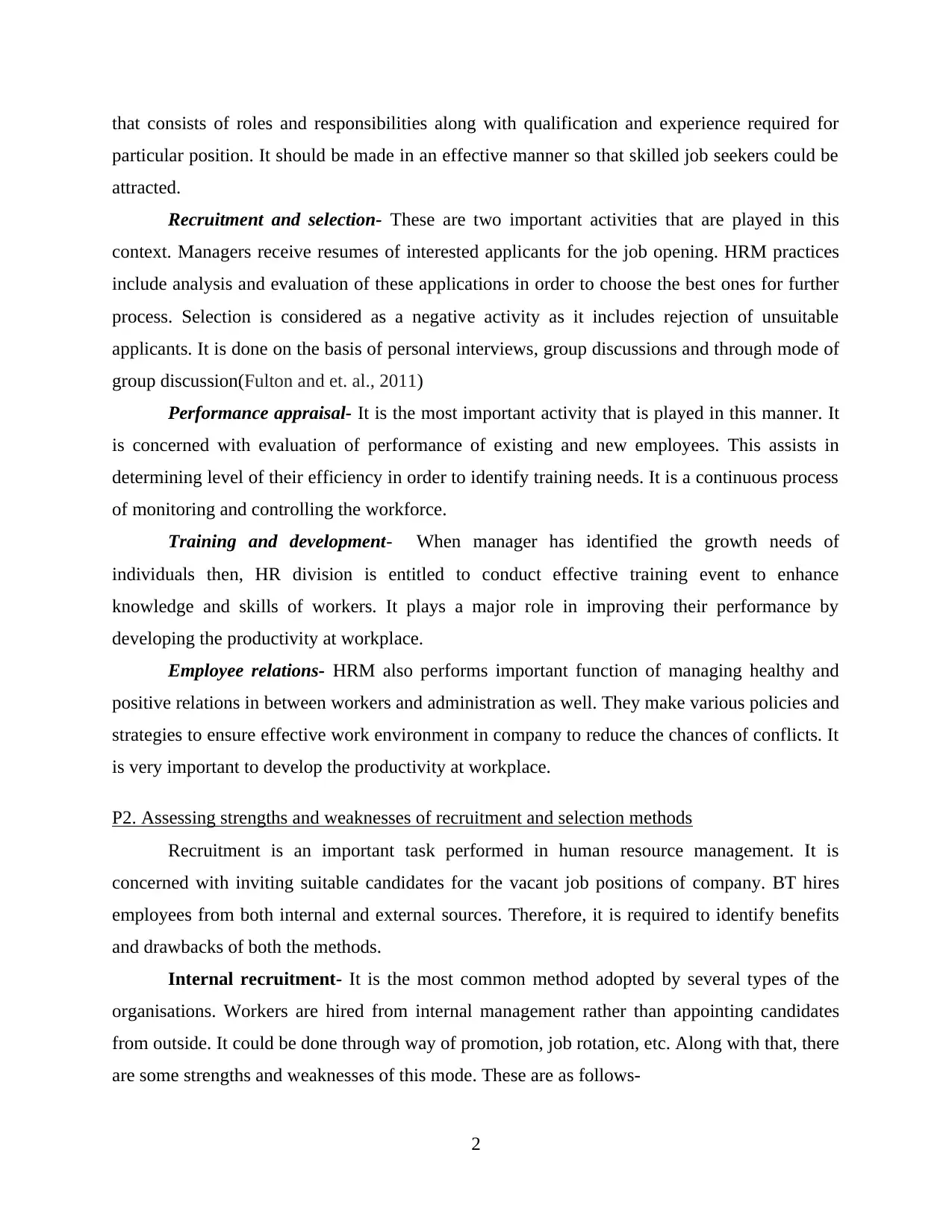
that consists of roles and responsibilities along with qualification and experience required for
particular position. It should be made in an effective manner so that skilled job seekers could be
attracted.
Recruitment and selection- These are two important activities that are played in this
context. Managers receive resumes of interested applicants for the job opening. HRM practices
include analysis and evaluation of these applications in order to choose the best ones for further
process. Selection is considered as a negative activity as it includes rejection of unsuitable
applicants. It is done on the basis of personal interviews, group discussions and through mode of
group discussion(Fulton and et. al., 2011)
Performance appraisal- It is the most important activity that is played in this manner. It
is concerned with evaluation of performance of existing and new employees. This assists in
determining level of their efficiency in order to identify training needs. It is a continuous process
of monitoring and controlling the workforce.
Training and development- When manager has identified the growth needs of
individuals then, HR division is entitled to conduct effective training event to enhance
knowledge and skills of workers. It plays a major role in improving their performance by
developing the productivity at workplace.
Employee relations- HRM also performs important function of managing healthy and
positive relations in between workers and administration as well. They make various policies and
strategies to ensure effective work environment in company to reduce the chances of conflicts. It
is very important to develop the productivity at workplace.
P2. Assessing strengths and weaknesses of recruitment and selection methods
Recruitment is an important task performed in human resource management. It is
concerned with inviting suitable candidates for the vacant job positions of company. BT hires
employees from both internal and external sources. Therefore, it is required to identify benefits
and drawbacks of both the methods.
Internal recruitment- It is the most common method adopted by several types of the
organisations. Workers are hired from internal management rather than appointing candidates
from outside. It could be done through way of promotion, job rotation, etc. Along with that, there
are some strengths and weaknesses of this mode. These are as follows-
2
particular position. It should be made in an effective manner so that skilled job seekers could be
attracted.
Recruitment and selection- These are two important activities that are played in this
context. Managers receive resumes of interested applicants for the job opening. HRM practices
include analysis and evaluation of these applications in order to choose the best ones for further
process. Selection is considered as a negative activity as it includes rejection of unsuitable
applicants. It is done on the basis of personal interviews, group discussions and through mode of
group discussion(Fulton and et. al., 2011)
Performance appraisal- It is the most important activity that is played in this manner. It
is concerned with evaluation of performance of existing and new employees. This assists in
determining level of their efficiency in order to identify training needs. It is a continuous process
of monitoring and controlling the workforce.
Training and development- When manager has identified the growth needs of
individuals then, HR division is entitled to conduct effective training event to enhance
knowledge and skills of workers. It plays a major role in improving their performance by
developing the productivity at workplace.
Employee relations- HRM also performs important function of managing healthy and
positive relations in between workers and administration as well. They make various policies and
strategies to ensure effective work environment in company to reduce the chances of conflicts. It
is very important to develop the productivity at workplace.
P2. Assessing strengths and weaknesses of recruitment and selection methods
Recruitment is an important task performed in human resource management. It is
concerned with inviting suitable candidates for the vacant job positions of company. BT hires
employees from both internal and external sources. Therefore, it is required to identify benefits
and drawbacks of both the methods.
Internal recruitment- It is the most common method adopted by several types of the
organisations. Workers are hired from internal management rather than appointing candidates
from outside. It could be done through way of promotion, job rotation, etc. Along with that, there
are some strengths and weaknesses of this mode. These are as follows-
2
Secure Best Marks with AI Grader
Need help grading? Try our AI Grader for instant feedback on your assignments.
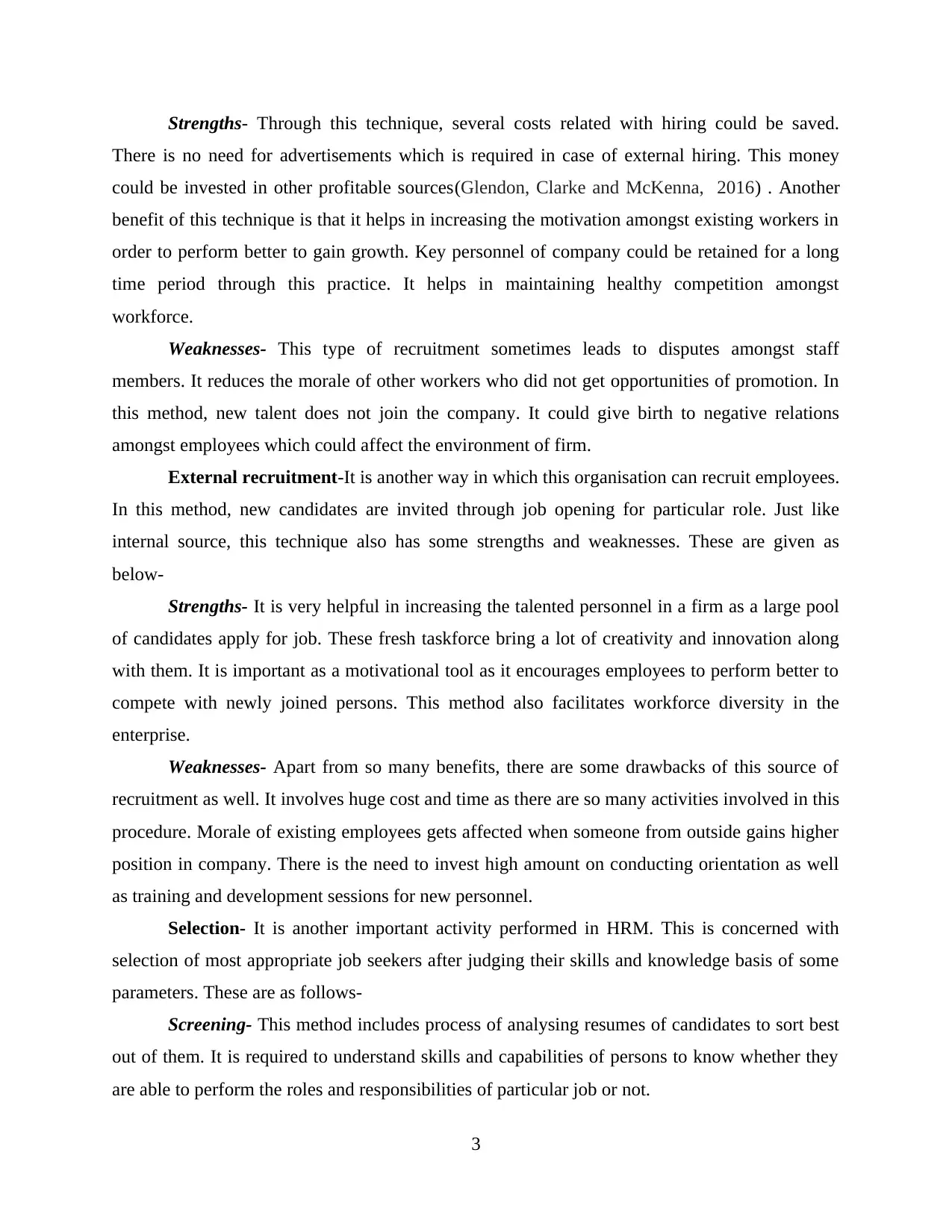
Strengths- Through this technique, several costs related with hiring could be saved.
There is no need for advertisements which is required in case of external hiring. This money
could be invested in other profitable sources(Glendon, Clarke and McKenna, 2016) . Another
benefit of this technique is that it helps in increasing the motivation amongst existing workers in
order to perform better to gain growth. Key personnel of company could be retained for a long
time period through this practice. It helps in maintaining healthy competition amongst
workforce.
Weaknesses- This type of recruitment sometimes leads to disputes amongst staff
members. It reduces the morale of other workers who did not get opportunities of promotion. In
this method, new talent does not join the company. It could give birth to negative relations
amongst employees which could affect the environment of firm.
External recruitment-It is another way in which this organisation can recruit employees.
In this method, new candidates are invited through job opening for particular role. Just like
internal source, this technique also has some strengths and weaknesses. These are given as
below-
Strengths- It is very helpful in increasing the talented personnel in a firm as a large pool
of candidates apply for job. These fresh taskforce bring a lot of creativity and innovation along
with them. It is important as a motivational tool as it encourages employees to perform better to
compete with newly joined persons. This method also facilitates workforce diversity in the
enterprise.
Weaknesses- Apart from so many benefits, there are some drawbacks of this source of
recruitment as well. It involves huge cost and time as there are so many activities involved in this
procedure. Morale of existing employees gets affected when someone from outside gains higher
position in company. There is the need to invest high amount on conducting orientation as well
as training and development sessions for new personnel.
Selection- It is another important activity performed in HRM. This is concerned with
selection of most appropriate job seekers after judging their skills and knowledge basis of some
parameters. These are as follows-
Screening- This method includes process of analysing resumes of candidates to sort best
out of them. It is required to understand skills and capabilities of persons to know whether they
are able to perform the roles and responsibilities of particular job or not.
3
There is no need for advertisements which is required in case of external hiring. This money
could be invested in other profitable sources(Glendon, Clarke and McKenna, 2016) . Another
benefit of this technique is that it helps in increasing the motivation amongst existing workers in
order to perform better to gain growth. Key personnel of company could be retained for a long
time period through this practice. It helps in maintaining healthy competition amongst
workforce.
Weaknesses- This type of recruitment sometimes leads to disputes amongst staff
members. It reduces the morale of other workers who did not get opportunities of promotion. In
this method, new talent does not join the company. It could give birth to negative relations
amongst employees which could affect the environment of firm.
External recruitment-It is another way in which this organisation can recruit employees.
In this method, new candidates are invited through job opening for particular role. Just like
internal source, this technique also has some strengths and weaknesses. These are given as
below-
Strengths- It is very helpful in increasing the talented personnel in a firm as a large pool
of candidates apply for job. These fresh taskforce bring a lot of creativity and innovation along
with them. It is important as a motivational tool as it encourages employees to perform better to
compete with newly joined persons. This method also facilitates workforce diversity in the
enterprise.
Weaknesses- Apart from so many benefits, there are some drawbacks of this source of
recruitment as well. It involves huge cost and time as there are so many activities involved in this
procedure. Morale of existing employees gets affected when someone from outside gains higher
position in company. There is the need to invest high amount on conducting orientation as well
as training and development sessions for new personnel.
Selection- It is another important activity performed in HRM. This is concerned with
selection of most appropriate job seekers after judging their skills and knowledge basis of some
parameters. These are as follows-
Screening- This method includes process of analysing resumes of candidates to sort best
out of them. It is required to understand skills and capabilities of persons to know whether they
are able to perform the roles and responsibilities of particular job or not.
3
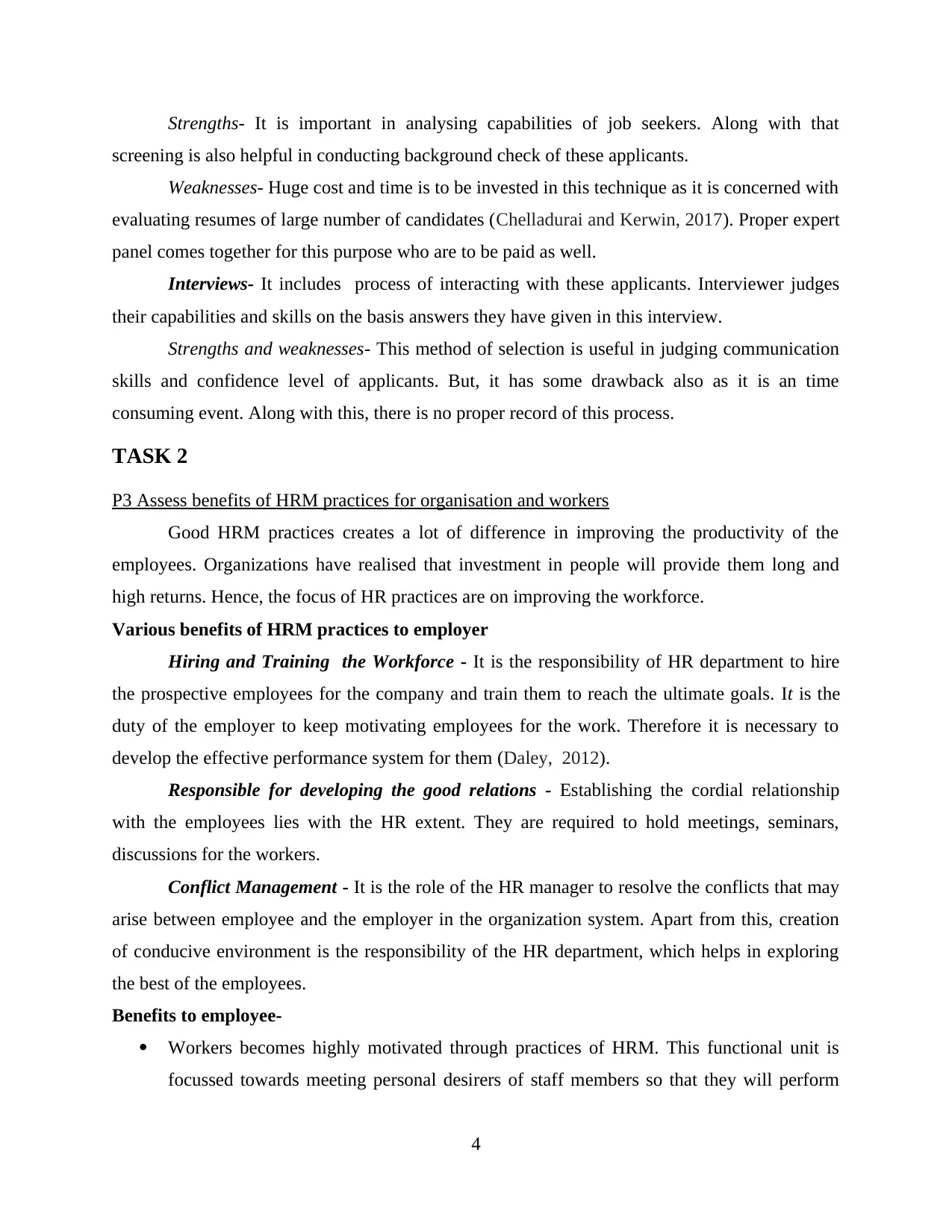
Strengths- It is important in analysing capabilities of job seekers. Along with that
screening is also helpful in conducting background check of these applicants.
Weaknesses- Huge cost and time is to be invested in this technique as it is concerned with
evaluating resumes of large number of candidates (Chelladurai and Kerwin, 2017). Proper expert
panel comes together for this purpose who are to be paid as well.
Interviews- It includes process of interacting with these applicants. Interviewer judges
their capabilities and skills on the basis answers they have given in this interview.
Strengths and weaknesses- This method of selection is useful in judging communication
skills and confidence level of applicants. But, it has some drawback also as it is an time
consuming event. Along with this, there is no proper record of this process.
TASK 2
P3 Assess benefits of HRM practices for organisation and workers
Good HRM practices creates a lot of difference in improving the productivity of the
employees. Organizations have realised that investment in people will provide them long and
high returns. Hence, the focus of HR practices are on improving the workforce.
Various benefits of HRM practices to employer
Hiring and Training the Workforce - It is the responsibility of HR department to hire
the prospective employees for the company and train them to reach the ultimate goals. It is the
duty of the employer to keep motivating employees for the work. Therefore it is necessary to
develop the effective performance system for them (Daley, 2012).
Responsible for developing the good relations - Establishing the cordial relationship
with the employees lies with the HR extent. They are required to hold meetings, seminars,
discussions for the workers.
Conflict Management - It is the role of the HR manager to resolve the conflicts that may
arise between employee and the employer in the organization system. Apart from this, creation
of conducive environment is the responsibility of the HR department, which helps in exploring
the best of the employees.
Benefits to employee-
Workers becomes highly motivated through practices of HRM. This functional unit is
focussed towards meeting personal desirers of staff members so that they will perform
4
screening is also helpful in conducting background check of these applicants.
Weaknesses- Huge cost and time is to be invested in this technique as it is concerned with
evaluating resumes of large number of candidates (Chelladurai and Kerwin, 2017). Proper expert
panel comes together for this purpose who are to be paid as well.
Interviews- It includes process of interacting with these applicants. Interviewer judges
their capabilities and skills on the basis answers they have given in this interview.
Strengths and weaknesses- This method of selection is useful in judging communication
skills and confidence level of applicants. But, it has some drawback also as it is an time
consuming event. Along with this, there is no proper record of this process.
TASK 2
P3 Assess benefits of HRM practices for organisation and workers
Good HRM practices creates a lot of difference in improving the productivity of the
employees. Organizations have realised that investment in people will provide them long and
high returns. Hence, the focus of HR practices are on improving the workforce.
Various benefits of HRM practices to employer
Hiring and Training the Workforce - It is the responsibility of HR department to hire
the prospective employees for the company and train them to reach the ultimate goals. It is the
duty of the employer to keep motivating employees for the work. Therefore it is necessary to
develop the effective performance system for them (Daley, 2012).
Responsible for developing the good relations - Establishing the cordial relationship
with the employees lies with the HR extent. They are required to hold meetings, seminars,
discussions for the workers.
Conflict Management - It is the role of the HR manager to resolve the conflicts that may
arise between employee and the employer in the organization system. Apart from this, creation
of conducive environment is the responsibility of the HR department, which helps in exploring
the best of the employees.
Benefits to employee-
Workers becomes highly motivated through practices of HRM. This functional unit is
focussed towards meeting personal desirers of staff members so that they will perform
4
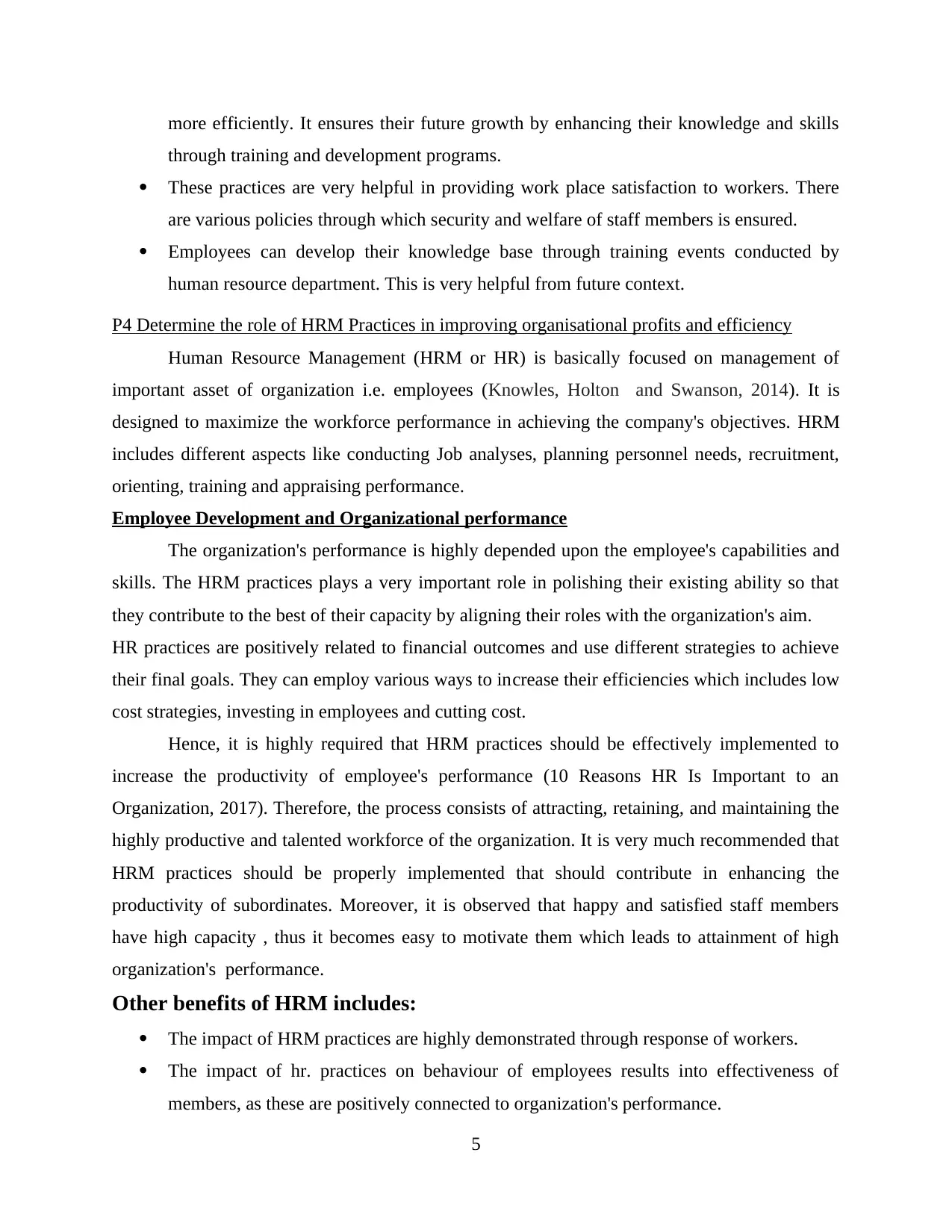
more efficiently. It ensures their future growth by enhancing their knowledge and skills
through training and development programs.
These practices are very helpful in providing work place satisfaction to workers. There
are various policies through which security and welfare of staff members is ensured.
Employees can develop their knowledge base through training events conducted by
human resource department. This is very helpful from future context.
P4 Determine the role of HRM Practices in improving organisational profits and efficiency
Human Resource Management (HRM or HR) is basically focused on management of
important asset of organization i.e. employees (Knowles, Holton and Swanson, 2014). It is
designed to maximize the workforce performance in achieving the company's objectives. HRM
includes different aspects like conducting Job analyses, planning personnel needs, recruitment,
orienting, training and appraising performance.
Employee Development and Organizational performance
The organization's performance is highly depended upon the employee's capabilities and
skills. The HRM practices plays a very important role in polishing their existing ability so that
they contribute to the best of their capacity by aligning their roles with the organization's aim.
HR practices are positively related to financial outcomes and use different strategies to achieve
their final goals. They can employ various ways to increase their efficiencies which includes low
cost strategies, investing in employees and cutting cost.
Hence, it is highly required that HRM practices should be effectively implemented to
increase the productivity of employee's performance (10 Reasons HR Is Important to an
Organization, 2017). Therefore, the process consists of attracting, retaining, and maintaining the
highly productive and talented workforce of the organization. It is very much recommended that
HRM practices should be properly implemented that should contribute in enhancing the
productivity of subordinates. Moreover, it is observed that happy and satisfied staff members
have high capacity , thus it becomes easy to motivate them which leads to attainment of high
organization's performance.
Other benefits of HRM includes:
The impact of HRM practices are highly demonstrated through response of workers.
The impact of hr. practices on behaviour of employees results into effectiveness of
members, as these are positively connected to organization's performance.
5
through training and development programs.
These practices are very helpful in providing work place satisfaction to workers. There
are various policies through which security and welfare of staff members is ensured.
Employees can develop their knowledge base through training events conducted by
human resource department. This is very helpful from future context.
P4 Determine the role of HRM Practices in improving organisational profits and efficiency
Human Resource Management (HRM or HR) is basically focused on management of
important asset of organization i.e. employees (Knowles, Holton and Swanson, 2014). It is
designed to maximize the workforce performance in achieving the company's objectives. HRM
includes different aspects like conducting Job analyses, planning personnel needs, recruitment,
orienting, training and appraising performance.
Employee Development and Organizational performance
The organization's performance is highly depended upon the employee's capabilities and
skills. The HRM practices plays a very important role in polishing their existing ability so that
they contribute to the best of their capacity by aligning their roles with the organization's aim.
HR practices are positively related to financial outcomes and use different strategies to achieve
their final goals. They can employ various ways to increase their efficiencies which includes low
cost strategies, investing in employees and cutting cost.
Hence, it is highly required that HRM practices should be effectively implemented to
increase the productivity of employee's performance (10 Reasons HR Is Important to an
Organization, 2017). Therefore, the process consists of attracting, retaining, and maintaining the
highly productive and talented workforce of the organization. It is very much recommended that
HRM practices should be properly implemented that should contribute in enhancing the
productivity of subordinates. Moreover, it is observed that happy and satisfied staff members
have high capacity , thus it becomes easy to motivate them which leads to attainment of high
organization's performance.
Other benefits of HRM includes:
The impact of HRM practices are highly demonstrated through response of workers.
The impact of hr. practices on behaviour of employees results into effectiveness of
members, as these are positively connected to organization's performance.
5
Paraphrase This Document
Need a fresh take? Get an instant paraphrase of this document with our AI Paraphraser
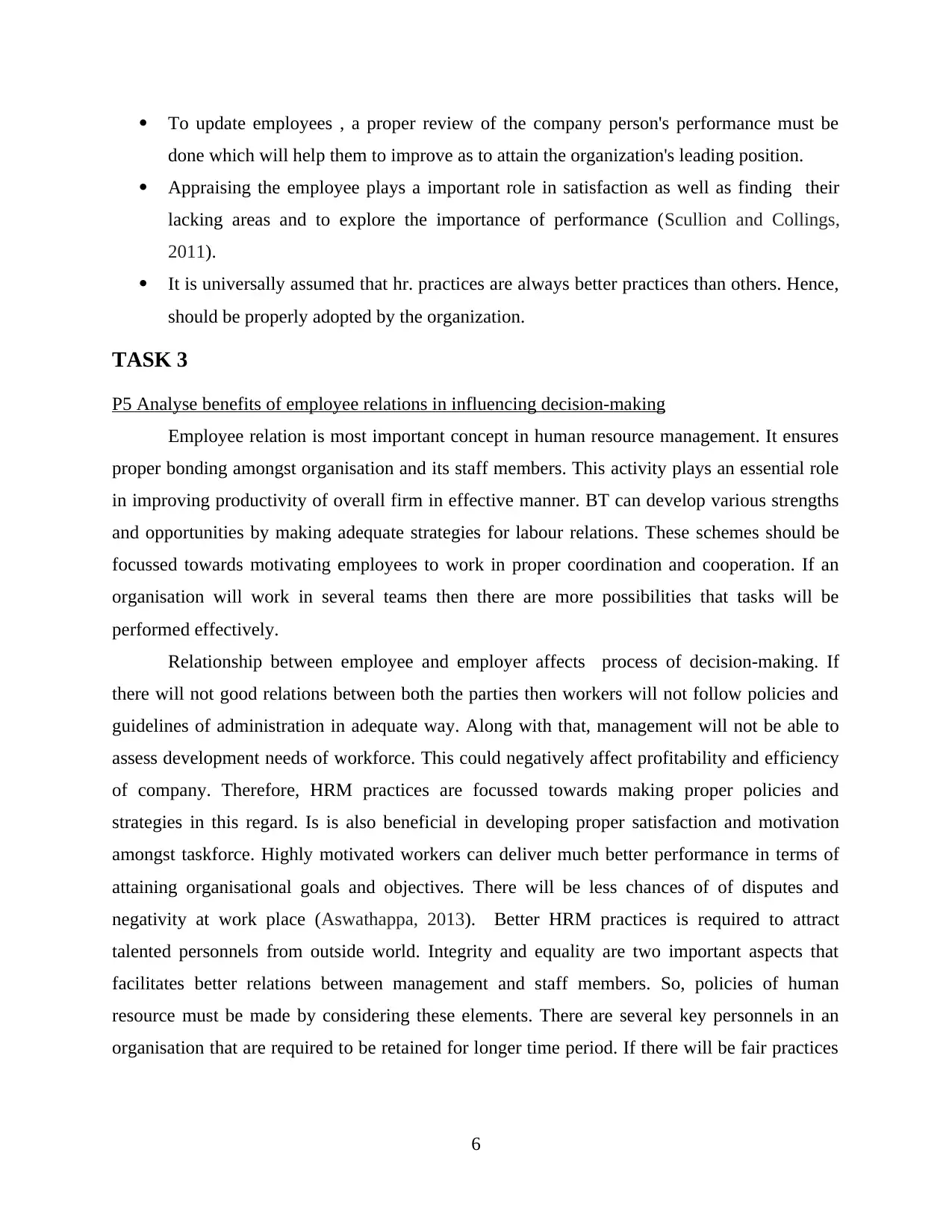
To update employees , a proper review of the company person's performance must be
done which will help them to improve as to attain the organization's leading position.
Appraising the employee plays a important role in satisfaction as well as finding their
lacking areas and to explore the importance of performance (Scullion and Collings,
2011).
It is universally assumed that hr. practices are always better practices than others. Hence,
should be properly adopted by the organization.
TASK 3
P5 Analyse benefits of employee relations in influencing decision-making
Employee relation is most important concept in human resource management. It ensures
proper bonding amongst organisation and its staff members. This activity plays an essential role
in improving productivity of overall firm in effective manner. BT can develop various strengths
and opportunities by making adequate strategies for labour relations. These schemes should be
focussed towards motivating employees to work in proper coordination and cooperation. If an
organisation will work in several teams then there are more possibilities that tasks will be
performed effectively.
Relationship between employee and employer affects process of decision-making. If
there will not good relations between both the parties then workers will not follow policies and
guidelines of administration in adequate way. Along with that, management will not be able to
assess development needs of workforce. This could negatively affect profitability and efficiency
of company. Therefore, HRM practices are focussed towards making proper policies and
strategies in this regard. Is is also beneficial in developing proper satisfaction and motivation
amongst taskforce. Highly motivated workers can deliver much better performance in terms of
attaining organisational goals and objectives. There will be less chances of of disputes and
negativity at work place (Aswathappa, 2013). Better HRM practices is required to attract
talented personnels from outside world. Integrity and equality are two important aspects that
facilitates better relations between management and staff members. So, policies of human
resource must be made by considering these elements. There are several key personnels in an
organisation that are required to be retained for longer time period. If there will be fair practices
6
done which will help them to improve as to attain the organization's leading position.
Appraising the employee plays a important role in satisfaction as well as finding their
lacking areas and to explore the importance of performance (Scullion and Collings,
2011).
It is universally assumed that hr. practices are always better practices than others. Hence,
should be properly adopted by the organization.
TASK 3
P5 Analyse benefits of employee relations in influencing decision-making
Employee relation is most important concept in human resource management. It ensures
proper bonding amongst organisation and its staff members. This activity plays an essential role
in improving productivity of overall firm in effective manner. BT can develop various strengths
and opportunities by making adequate strategies for labour relations. These schemes should be
focussed towards motivating employees to work in proper coordination and cooperation. If an
organisation will work in several teams then there are more possibilities that tasks will be
performed effectively.
Relationship between employee and employer affects process of decision-making. If
there will not good relations between both the parties then workers will not follow policies and
guidelines of administration in adequate way. Along with that, management will not be able to
assess development needs of workforce. This could negatively affect profitability and efficiency
of company. Therefore, HRM practices are focussed towards making proper policies and
strategies in this regard. Is is also beneficial in developing proper satisfaction and motivation
amongst taskforce. Highly motivated workers can deliver much better performance in terms of
attaining organisational goals and objectives. There will be less chances of of disputes and
negativity at work place (Aswathappa, 2013). Better HRM practices is required to attract
talented personnels from outside world. Integrity and equality are two important aspects that
facilitates better relations between management and staff members. So, policies of human
resource must be made by considering these elements. There are several key personnels in an
organisation that are required to be retained for longer time period. If there will be fair practices
6
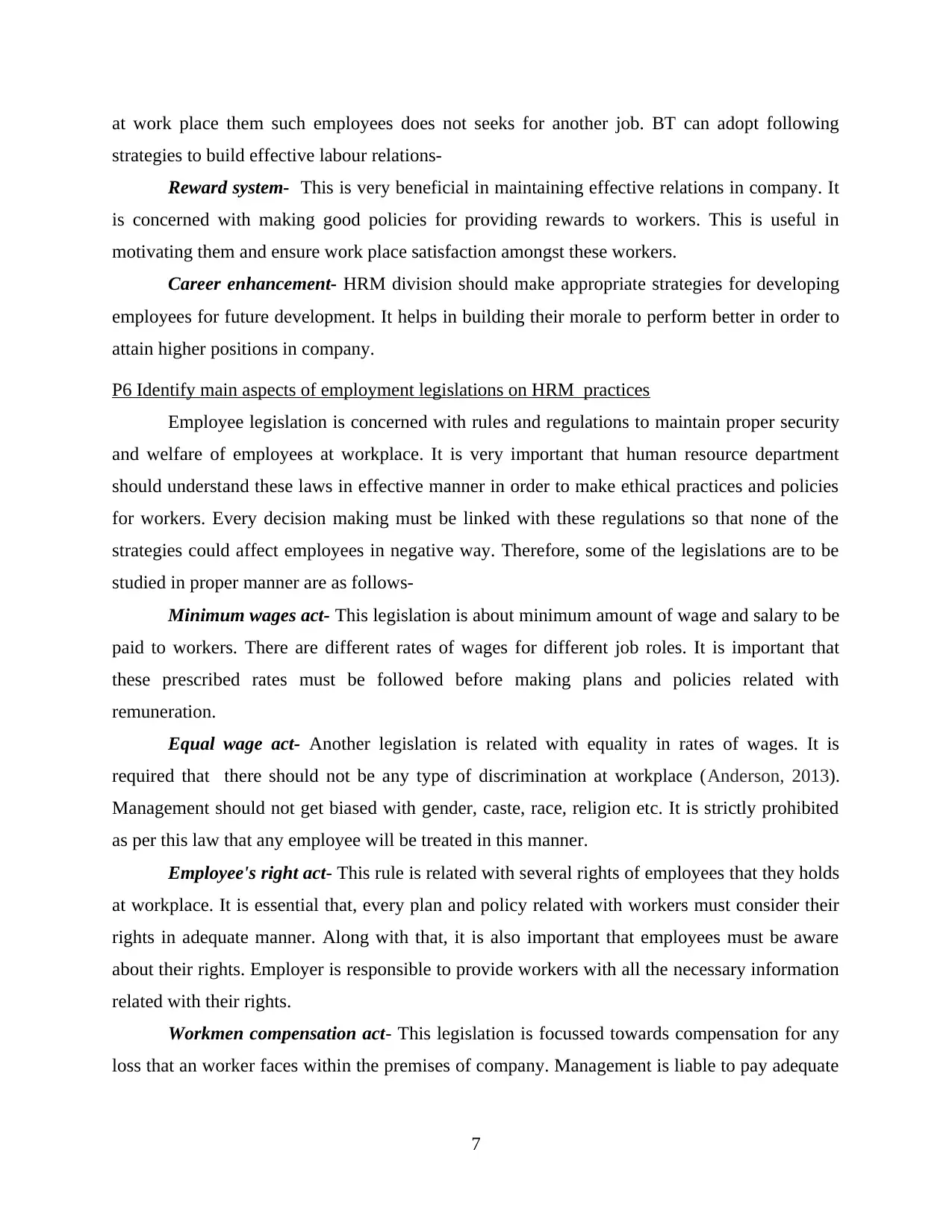
at work place them such employees does not seeks for another job. BT can adopt following
strategies to build effective labour relations-
Reward system- This is very beneficial in maintaining effective relations in company. It
is concerned with making good policies for providing rewards to workers. This is useful in
motivating them and ensure work place satisfaction amongst these workers.
Career enhancement- HRM division should make appropriate strategies for developing
employees for future development. It helps in building their morale to perform better in order to
attain higher positions in company.
P6 Identify main aspects of employment legislations on HRM practices
Employee legislation is concerned with rules and regulations to maintain proper security
and welfare of employees at workplace. It is very important that human resource department
should understand these laws in effective manner in order to make ethical practices and policies
for workers. Every decision making must be linked with these regulations so that none of the
strategies could affect employees in negative way. Therefore, some of the legislations are to be
studied in proper manner are as follows-
Minimum wages act- This legislation is about minimum amount of wage and salary to be
paid to workers. There are different rates of wages for different job roles. It is important that
these prescribed rates must be followed before making plans and policies related with
remuneration.
Equal wage act- Another legislation is related with equality in rates of wages. It is
required that there should not be any type of discrimination at workplace (Anderson, 2013).
Management should not get biased with gender, caste, race, religion etc. It is strictly prohibited
as per this law that any employee will be treated in this manner.
Employee's right act- This rule is related with several rights of employees that they holds
at workplace. It is essential that, every plan and policy related with workers must consider their
rights in adequate manner. Along with that, it is also important that employees must be aware
about their rights. Employer is responsible to provide workers with all the necessary information
related with their rights.
Workmen compensation act- This legislation is focussed towards compensation for any
loss that an worker faces within the premises of company. Management is liable to pay adequate
7
strategies to build effective labour relations-
Reward system- This is very beneficial in maintaining effective relations in company. It
is concerned with making good policies for providing rewards to workers. This is useful in
motivating them and ensure work place satisfaction amongst these workers.
Career enhancement- HRM division should make appropriate strategies for developing
employees for future development. It helps in building their morale to perform better in order to
attain higher positions in company.
P6 Identify main aspects of employment legislations on HRM practices
Employee legislation is concerned with rules and regulations to maintain proper security
and welfare of employees at workplace. It is very important that human resource department
should understand these laws in effective manner in order to make ethical practices and policies
for workers. Every decision making must be linked with these regulations so that none of the
strategies could affect employees in negative way. Therefore, some of the legislations are to be
studied in proper manner are as follows-
Minimum wages act- This legislation is about minimum amount of wage and salary to be
paid to workers. There are different rates of wages for different job roles. It is important that
these prescribed rates must be followed before making plans and policies related with
remuneration.
Equal wage act- Another legislation is related with equality in rates of wages. It is
required that there should not be any type of discrimination at workplace (Anderson, 2013).
Management should not get biased with gender, caste, race, religion etc. It is strictly prohibited
as per this law that any employee will be treated in this manner.
Employee's right act- This rule is related with several rights of employees that they holds
at workplace. It is essential that, every plan and policy related with workers must consider their
rights in adequate manner. Along with that, it is also important that employees must be aware
about their rights. Employer is responsible to provide workers with all the necessary information
related with their rights.
Workmen compensation act- This legislation is focussed towards compensation for any
loss that an worker faces within the premises of company. Management is liable to pay adequate
7
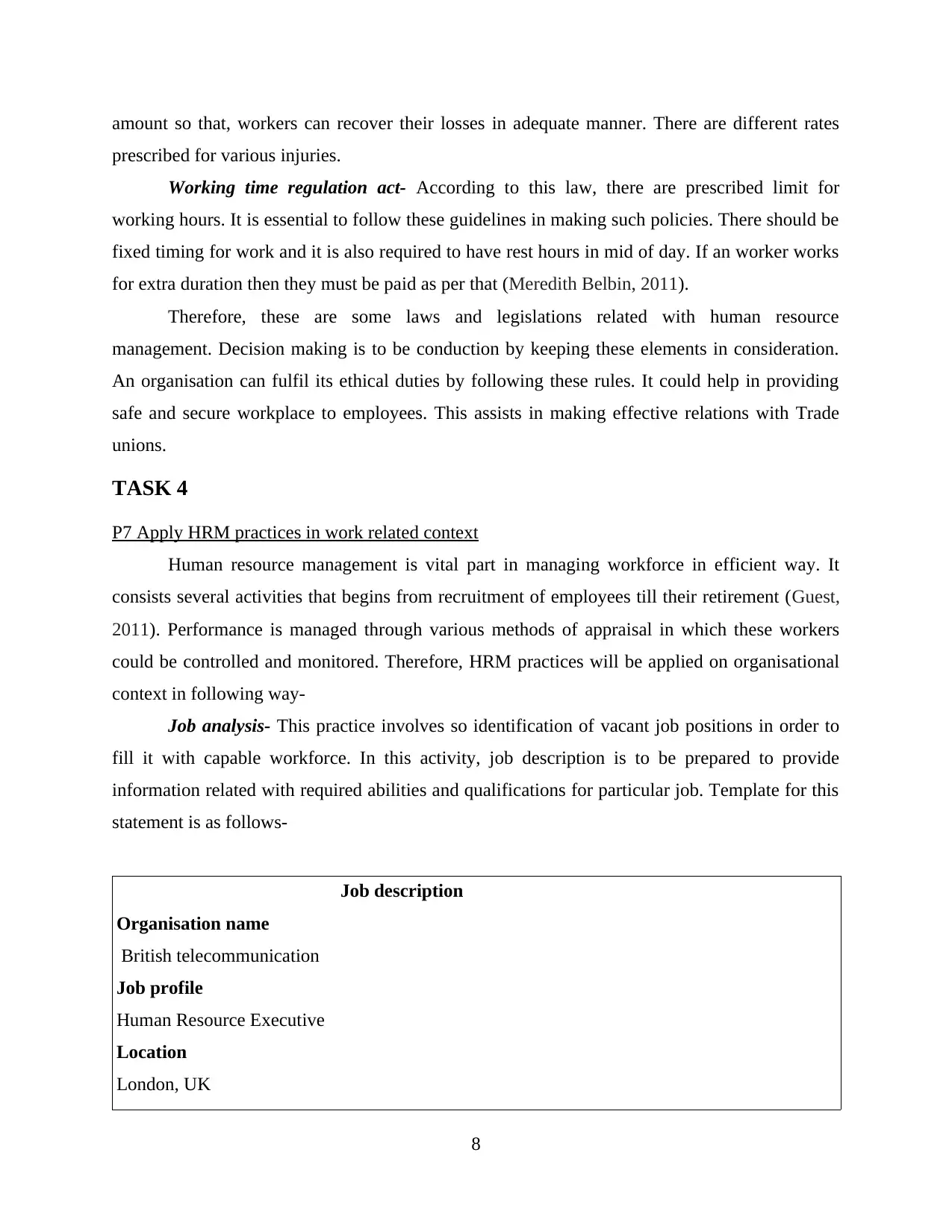
amount so that, workers can recover their losses in adequate manner. There are different rates
prescribed for various injuries.
Working time regulation act- According to this law, there are prescribed limit for
working hours. It is essential to follow these guidelines in making such policies. There should be
fixed timing for work and it is also required to have rest hours in mid of day. If an worker works
for extra duration then they must be paid as per that (Meredith Belbin, 2011).
Therefore, these are some laws and legislations related with human resource
management. Decision making is to be conduction by keeping these elements in consideration.
An organisation can fulfil its ethical duties by following these rules. It could help in providing
safe and secure workplace to employees. This assists in making effective relations with Trade
unions.
TASK 4
P7 Apply HRM practices in work related context
Human resource management is vital part in managing workforce in efficient way. It
consists several activities that begins from recruitment of employees till their retirement (Guest,
2011). Performance is managed through various methods of appraisal in which these workers
could be controlled and monitored. Therefore, HRM practices will be applied on organisational
context in following way-
Job analysis- This practice involves so identification of vacant job positions in order to
fill it with capable workforce. In this activity, job description is to be prepared to provide
information related with required abilities and qualifications for particular job. Template for this
statement is as follows-
Job description
Organisation name
British telecommunication
Job profile
Human Resource Executive
Location
London, UK
8
prescribed for various injuries.
Working time regulation act- According to this law, there are prescribed limit for
working hours. It is essential to follow these guidelines in making such policies. There should be
fixed timing for work and it is also required to have rest hours in mid of day. If an worker works
for extra duration then they must be paid as per that (Meredith Belbin, 2011).
Therefore, these are some laws and legislations related with human resource
management. Decision making is to be conduction by keeping these elements in consideration.
An organisation can fulfil its ethical duties by following these rules. It could help in providing
safe and secure workplace to employees. This assists in making effective relations with Trade
unions.
TASK 4
P7 Apply HRM practices in work related context
Human resource management is vital part in managing workforce in efficient way. It
consists several activities that begins from recruitment of employees till their retirement (Guest,
2011). Performance is managed through various methods of appraisal in which these workers
could be controlled and monitored. Therefore, HRM practices will be applied on organisational
context in following way-
Job analysis- This practice involves so identification of vacant job positions in order to
fill it with capable workforce. In this activity, job description is to be prepared to provide
information related with required abilities and qualifications for particular job. Template for this
statement is as follows-
Job description
Organisation name
British telecommunication
Job profile
Human Resource Executive
Location
London, UK
8
Secure Best Marks with AI Grader
Need help grading? Try our AI Grader for instant feedback on your assignments.
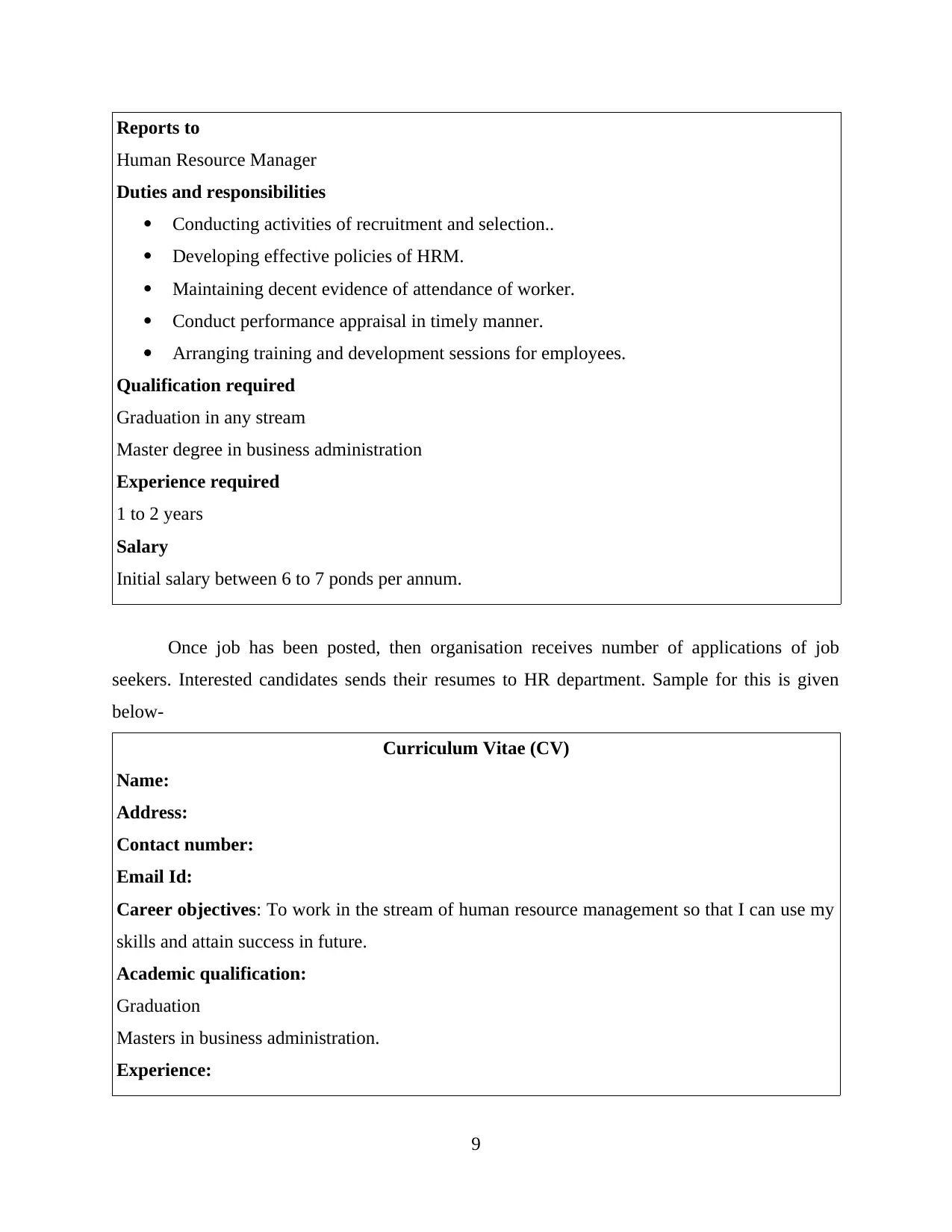
Reports to
Human Resource Manager
Duties and responsibilities
Conducting activities of recruitment and selection..
Developing effective policies of HRM.
Maintaining decent evidence of attendance of worker.
Conduct performance appraisal in timely manner.
Arranging training and development sessions for employees.
Qualification required
Graduation in any stream
Master degree in business administration
Experience required
1 to 2 years
Salary
Initial salary between 6 to 7 ponds per annum.
Once job has been posted, then organisation receives number of applications of job
seekers. Interested candidates sends their resumes to HR department. Sample for this is given
below-
Curriculum Vitae (CV)
Name:
Address:
Contact number:
Email Id:
Career objectives: To work in the stream of human resource management so that I can use my
skills and attain success in future.
Academic qualification:
Graduation
Masters in business administration.
Experience:
9
Human Resource Manager
Duties and responsibilities
Conducting activities of recruitment and selection..
Developing effective policies of HRM.
Maintaining decent evidence of attendance of worker.
Conduct performance appraisal in timely manner.
Arranging training and development sessions for employees.
Qualification required
Graduation in any stream
Master degree in business administration
Experience required
1 to 2 years
Salary
Initial salary between 6 to 7 ponds per annum.
Once job has been posted, then organisation receives number of applications of job
seekers. Interested candidates sends their resumes to HR department. Sample for this is given
below-
Curriculum Vitae (CV)
Name:
Address:
Contact number:
Email Id:
Career objectives: To work in the stream of human resource management so that I can use my
skills and attain success in future.
Academic qualification:
Graduation
Masters in business administration.
Experience:
9
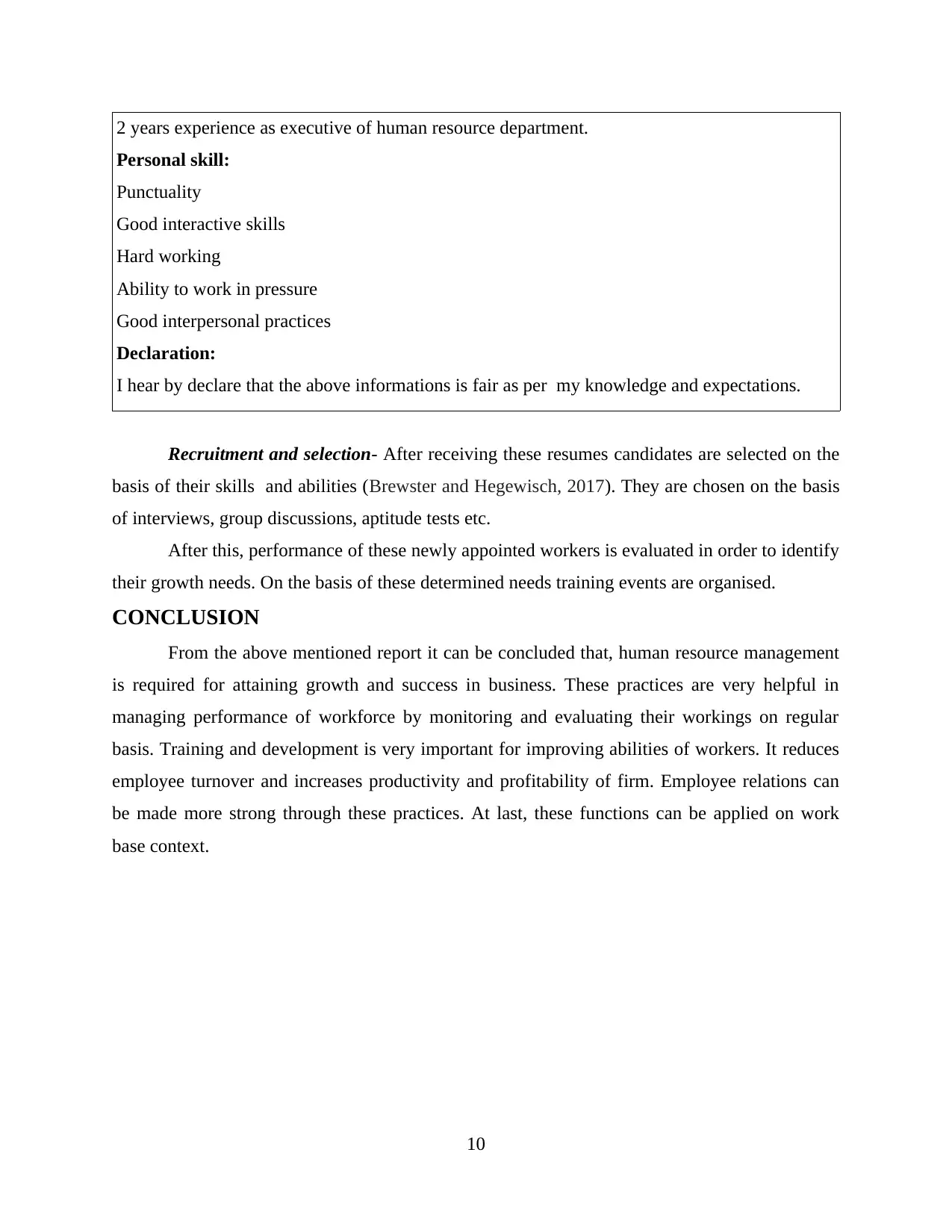
2 years experience as executive of human resource department.
Personal skill:
Punctuality
Good interactive skills
Hard working
Ability to work in pressure
Good interpersonal practices
Declaration:
I hear by declare that the above informations is fair as per my knowledge and expectations.
Recruitment and selection- After receiving these resumes candidates are selected on the
basis of their skills and abilities (Brewster and Hegewisch, 2017). They are chosen on the basis
of interviews, group discussions, aptitude tests etc.
After this, performance of these newly appointed workers is evaluated in order to identify
their growth needs. On the basis of these determined needs training events are organised.
CONCLUSION
From the above mentioned report it can be concluded that, human resource management
is required for attaining growth and success in business. These practices are very helpful in
managing performance of workforce by monitoring and evaluating their workings on regular
basis. Training and development is very important for improving abilities of workers. It reduces
employee turnover and increases productivity and profitability of firm. Employee relations can
be made more strong through these practices. At last, these functions can be applied on work
base context.
10
Personal skill:
Punctuality
Good interactive skills
Hard working
Ability to work in pressure
Good interpersonal practices
Declaration:
I hear by declare that the above informations is fair as per my knowledge and expectations.
Recruitment and selection- After receiving these resumes candidates are selected on the
basis of their skills and abilities (Brewster and Hegewisch, 2017). They are chosen on the basis
of interviews, group discussions, aptitude tests etc.
After this, performance of these newly appointed workers is evaluated in order to identify
their growth needs. On the basis of these determined needs training events are organised.
CONCLUSION
From the above mentioned report it can be concluded that, human resource management
is required for attaining growth and success in business. These practices are very helpful in
managing performance of workforce by monitoring and evaluating their workings on regular
basis. Training and development is very important for improving abilities of workers. It reduces
employee turnover and increases productivity and profitability of firm. Employee relations can
be made more strong through these practices. At last, these functions can be applied on work
base context.
10
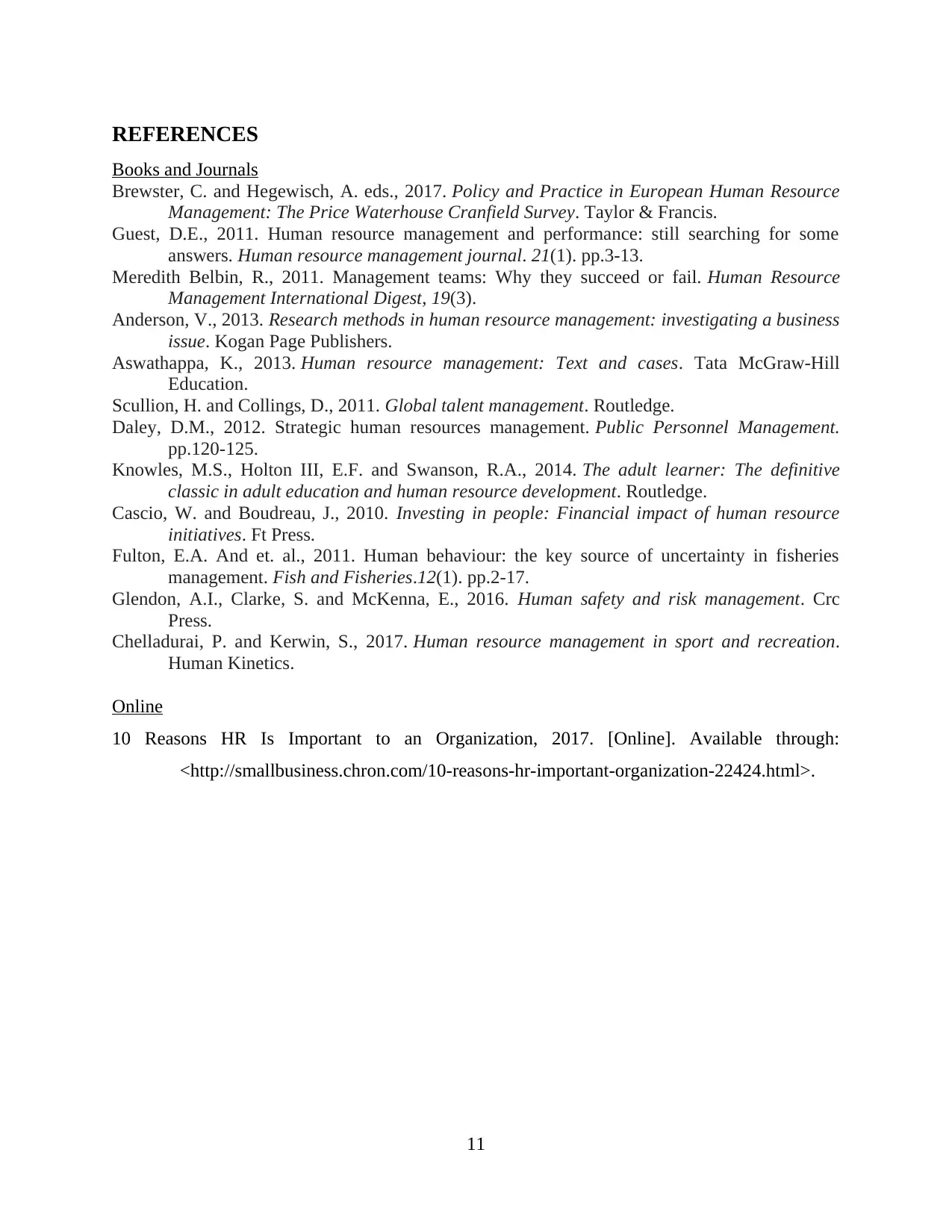
REFERENCES
Books and Journals
Brewster, C. and Hegewisch, A. eds., 2017. Policy and Practice in European Human Resource
Management: The Price Waterhouse Cranfield Survey. Taylor & Francis.
Guest, D.E., 2011. Human resource management and performance: still searching for some
answers. Human resource management journal. 21(1). pp.3-13.
Meredith Belbin, R., 2011. Management teams: Why they succeed or fail. Human Resource
Management International Digest, 19(3).
Anderson, V., 2013. Research methods in human resource management: investigating a business
issue. Kogan Page Publishers.
Aswathappa, K., 2013. Human resource management: Text and cases. Tata McGraw-Hill
Education.
Scullion, H. and Collings, D., 2011. Global talent management. Routledge.
Daley, D.M., 2012. Strategic human resources management. Public Personnel Management.
pp.120-125.
Knowles, M.S., Holton III, E.F. and Swanson, R.A., 2014. The adult learner: The definitive
classic in adult education and human resource development. Routledge.
Cascio, W. and Boudreau, J., 2010. Investing in people: Financial impact of human resource
initiatives. Ft Press.
Fulton, E.A. And et. al., 2011. Human behaviour: the key source of uncertainty in fisheries
management. Fish and Fisheries.12(1). pp.2-17.
Glendon, A.I., Clarke, S. and McKenna, E., 2016. Human safety and risk management. Crc
Press.
Chelladurai, P. and Kerwin, S., 2017. Human resource management in sport and recreation.
Human Kinetics.
Online
10 Reasons HR Is Important to an Organization, 2017. [Online]. Available through:
<http://smallbusiness.chron.com/10-reasons-hr-important-organization-22424.html>.
11
Books and Journals
Brewster, C. and Hegewisch, A. eds., 2017. Policy and Practice in European Human Resource
Management: The Price Waterhouse Cranfield Survey. Taylor & Francis.
Guest, D.E., 2011. Human resource management and performance: still searching for some
answers. Human resource management journal. 21(1). pp.3-13.
Meredith Belbin, R., 2011. Management teams: Why they succeed or fail. Human Resource
Management International Digest, 19(3).
Anderson, V., 2013. Research methods in human resource management: investigating a business
issue. Kogan Page Publishers.
Aswathappa, K., 2013. Human resource management: Text and cases. Tata McGraw-Hill
Education.
Scullion, H. and Collings, D., 2011. Global talent management. Routledge.
Daley, D.M., 2012. Strategic human resources management. Public Personnel Management.
pp.120-125.
Knowles, M.S., Holton III, E.F. and Swanson, R.A., 2014. The adult learner: The definitive
classic in adult education and human resource development. Routledge.
Cascio, W. and Boudreau, J., 2010. Investing in people: Financial impact of human resource
initiatives. Ft Press.
Fulton, E.A. And et. al., 2011. Human behaviour: the key source of uncertainty in fisheries
management. Fish and Fisheries.12(1). pp.2-17.
Glendon, A.I., Clarke, S. and McKenna, E., 2016. Human safety and risk management. Crc
Press.
Chelladurai, P. and Kerwin, S., 2017. Human resource management in sport and recreation.
Human Kinetics.
Online
10 Reasons HR Is Important to an Organization, 2017. [Online]. Available through:
<http://smallbusiness.chron.com/10-reasons-hr-important-organization-22424.html>.
11
1 out of 13
Related Documents
Your All-in-One AI-Powered Toolkit for Academic Success.
+13062052269
info@desklib.com
Available 24*7 on WhatsApp / Email
![[object Object]](/_next/static/media/star-bottom.7253800d.svg)
Unlock your academic potential
© 2024 | Zucol Services PVT LTD | All rights reserved.





